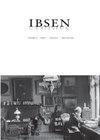The Contemporary Reception of Little Eyolf and its Presentation in Henrik Ibsens Skrifter
IF 0.1
0 THEATER
引用次数: 0
Abstract
With its broad presentation of the contemporary reception of each of Ibsen’s dramas, Henrik Ibsens Skrifter (HIS) certainly represents a giant step forward compared to its predecessor Hundreårsutgaven (HU, The Centenary Edition). On the whole, the reception chapters in the introductions provide students and scholars with thorough accounts of how the printed editions of the plays were received and read in Scandinavia. In fact, with some of these chapters filling 20 pages or more (cf. the introductions to Hedda Gabler in HIS 9k and When We Dead Awaken in volume 10k), the extensiveness becomes a problem in itself, raising the question of whether one should present highlights from the reception, a representative selection, or lock, stock and barrel. On closer inspection, it is obvious that there is an inconsistent practice when it comes to form, structure and content of the reception chapters in HIS. Unfortunately, no clear principles were laid down from the outset concerning what to include and how to present the reception of the written plays. These problems regarding the reception chapters of HIS, are discussed in the first part of this article. In the second (last) part, I will comment in detail on HIS’s presentation of the reception of one of the plays, Little Eyolf (LE), published in 1894 and the last but two of Ibsen’s dramas. For several reasons, LE is particularly interesting in the history of Ibsen reception, not least because this relatively obscure play, unlike some of the more celebrated Ibsen dramas, actually received generally positive reviews in its time.小爱的当代接受及其在斯克里夫特的表现
《亨利克·易卜生日记》(HIS)广泛地呈现了易卜生每一部戏剧在当代的接受程度,与它的前身《百年纪念版》(HU)相比,它无疑是一个巨大的进步。总的来说,引言中的接受章节为学生和学者提供了关于戏剧印刷版本在斯堪的纳维亚是如何被接受和阅读的详细描述。事实上,有些章节的篇幅甚至超过了20页(参见《赫达·盖博勒》第9k卷的介绍和《当我们死去时》第10k卷的介绍),这种广泛性本身就成了一个问题,提出了一个问题,即人们是应该从接待中呈现亮点,还是代表性的选择,还是锁定,库存和桶。仔细观察就会发现,《医疗卫生系统》的接待章节在形式、结构和内容上明显存在着不一致的做法。不幸的是,从一开始就没有明确的原则规定应该包括什么以及如何呈现剧本的接受。本文的第一部分讨论了《高等教育信息系统》接收章节中存在的问题。在第二部分(最后一部分),我将详细评论他对1894年出版的易卜生戏剧之一《小埃尔夫》(LE)的接受情况的介绍,这是易卜生的最后两部戏剧。出于几个原因,《LE》在易卜生的接受史上特别有趣,尤其是因为这部相对晦涩的戏剧,不像一些更著名的易卜生戏剧,实际上在当时得到了普遍的好评。
本文章由计算机程序翻译,如有差异,请以英文原文为准。
求助全文
约1分钟内获得全文
求助全文

 求助内容:
求助内容: 应助结果提醒方式:
应助结果提醒方式:


